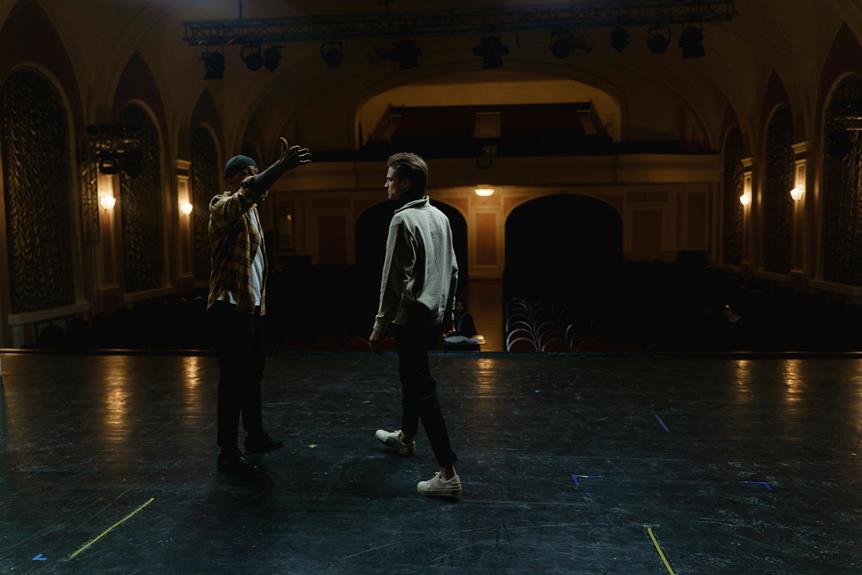When you think about theater, you might not immediately consider muslin, yet it's an essential fabric that shapes both costumes and sets. Its lightweight nature provides comfort for performers, allowing them to express themselves fully on stage. Meanwhile, muslin's adaptability makes it a favorite for set designers aiming to create visually striking environments. But the true versatility of muslin goes beyond these basics. Have you ever wondered how innovative techniques can elevate a production's aesthetic and functionality?
Table of Contents
Key Takeaways
- Muslin is a lightweight and breathable fabric ideal for crafting comfortable costumes that allow performers to move freely on stage.
- The versatility of muslin enables its use for dynamic backdrops and scenic elements, enhancing the overall atmosphere of theater productions.
- Muslin can be easily dyed, painted, or printed, allowing for customization in both costumes and set designs to fit specific production needs.
- Pre-washing muslin prevents shrinkage, ensuring costumes and set pieces maintain their intended appearance throughout performances.
Overview of Muslin Fabric
Muslin is a versatile cotton fabric known for its lightweight and breathable qualities, making it a favorite choice in theater production. You'll find that it's often used for draping, backdrops, and other scenic elements because it's easy to work with and can be manipulated in various ways. Its natural finish allows for seamless integration into different production designs, whether you're going for a rustic feel or a more polished look.
Additionally, muslin comes in various weights and weaves, which means you can choose the right type for your specific needs. The lighter weights are perfect for creating airy, flowing curtains or delicate scenery, while the heavier options provide durability for repeated use in more demanding environments.
One of the best things about muslin is its affordability. You won't break the bank sourcing it, allowing you to allocate funds to other essential aspects of your production. Plus, it's easy to dye, paint, or print on, so you can customize it to fit your creative vision.
Costumes: Design and Functionality
When designing costumes for theater, it's crucial to balance aesthetic appeal with functionality to ensure performers can move comfortably and expressively on stage. Muslin plays a key role in achieving this balance. Its lightweight and breathable properties make it an ideal choice for layering, allowing you to create intricate designs without sacrificing comfort.
Think about the character's movements when selecting fabric. If the role requires a lot of action, opt for a design that allows for flexibility and ease of movement. Muslin can be manipulated easily, whether you're draping, gathering, or crafting tailored pieces. You can also dye or paint muslin to add visual interest, enhancing your character's look while keeping practicality in mind.
Don't forget about the fit. A well-fitted costume not only looks better but also enhances a performer's confidence on stage. Consider using muslin for mock-ups to perfect the design before committing to the final piece. This way, you can identify any adjustments needed for movement and comfort.
Ultimately, effective costume design should support the story you're telling, giving performers the freedom to embody their characters fully while looking visually stunning.
Set Design: Creating Atmosphere
The choice of materials in costume design, like muslin, can greatly influence the overall atmosphere of a set, helping to create a cohesive and immersive experience for the audience. When you use muslin in set design, you're not just choosing a fabric; you're selecting a medium that can transform the space and evoke emotions.
Here are some ways muslin can enhance your set design:
- Lightweight Versatility: Muslin is easy to manipulate, making it perfect for creating dynamic backdrops or drapery that flows with movement.
- Texture and Depth: The fabric's texture adds layers to your set, creating visual interest and depth that draws the audience in.
- Color Absorption: Muslin can take on paint and dye beautifully, allowing you to create a range of atmospheric colors that set the mood for each scene.
Techniques for Working With Muslin
Working with muslin requires a few key techniques to ensure you achieve the desired effects in your set design.
First, you should pre-wash your muslin to prevent shrinkage and remove any chemicals. This way, your fabric maintains its size and appearance throughout the production. When cutting muslin, always use sharp fabric scissors for clean edges, and consider using a rotary cutter for larger pieces.
Next, familiarize yourself with various dyeing techniques, like immersion dyeing or spray painting, to create unique textures and colors. If you're painting directly on muslin, use fabric paint or acrylics mixed with a fabric medium to ensure flexibility. Always test on a scrap piece first to see how the fabric absorbs the paint.
When attaching muslin to your set, use staples, hot glue, or sewing for secure placement. You can also consider creating a frame or using tension rods for a more polished look.
Lastly, experiment with layering different pieces of muslin to achieve depth and dimension in your design. By following these techniques, you'll be well on your way to crafting stunning and effective set pieces that enhance your production.
Examples of Muslin in Productions
Muslin has been used in various productions to create versatile backdrops and set pieces that enhance the overall visual experience. You'll often find it employed in theater, film, and even dance performances, thanks to its adaptability and ease of use.
Here are some notable examples of muslin in productions:
- Backdrop for Classical Plays: Many classic plays, like 'A Midsummer Night's Dream,' utilize muslin to create dreamy landscapes that transform the stage into ethereal settings.
- Scenic Panels: In modern musicals, muslin panels can be painted or printed, allowing for quick scene changes while maintaining visual continuity.
- Costume Design: Costumes made from muslin can be lightweight and breathable, perfect for dancers or actors who need to move freely.
Using muslin not only saves time and money but also opens up endless creative possibilities in staging. You'll appreciate its role in crafting immersive theatrical experiences while making the production process smoother.
Frequently Asked Questions
Can Muslin Be Painted or Dyed for Specific Designs?
Yes, you can paint or dye muslin for specific designs. Just ensure you use the right fabric paints or dyes, and always test on a small piece first to achieve your desired effect without damaging the fabric.
Is Muslin Environmentally Friendly or Sustainable?
Muslin's often considered a sustainable option since it's made from natural fibers, like cotton. However, the environmental impact depends on farming practices and production methods, so always check for organic certifications to ensure eco-friendliness.
How Does Muslin Compare to Other Fabric Types?
When you compare muslin to other fabrics, you'll find it's lightweight, breathable, and versatile. Unlike heavier materials, it drapes easily and allows for vibrant dyeing, making it a popular choice for various applications.
What Are Common Care Instructions for Muslin Costumes?
When caring for muslin costumes, you should hand wash them in cold water with mild detergent. Avoid bleach, and air dry to maintain the fabric's integrity. Iron on low heat if needed, using a press cloth.
Where Can I Buy High-Quality Muslin Fabric?
You can buy high-quality muslin fabric at local fabric stores, craft shops, or online retailers like Amazon and Etsy. Always check reviews to ensure you're getting the best quality for your projects.
- What Is Suede Cloth Fabric? - July 12, 2025
- How to Sew a Button on Suede Fabric - July 12, 2025
- What Is Comfort Suede Fabric? - July 12, 2025



